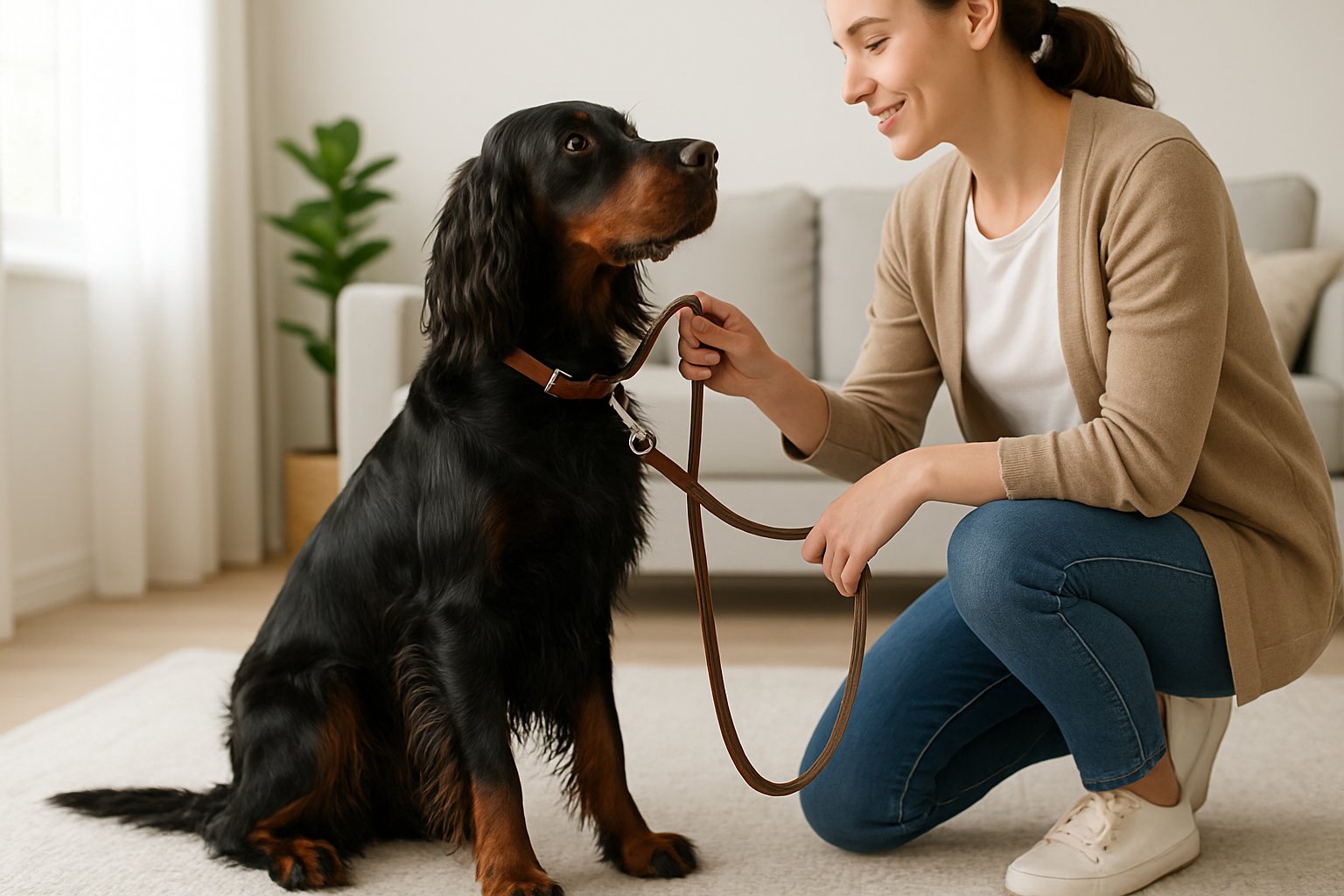Training your Gordon Setter helps create a smoother and more enjoyable life together. With the right approach, you can help your dog grow into a happy and polite companion. Proper training builds a stronger bond between you and your Gordon Setter while encouraging good behavior.
Gordon Setters are known for their energy and friendly nature, but they need guidance to thrive. Understanding their unique needs makes it easier to help them fit into your home and daily routine.
1. Start leash training indoors with short, positive sessions
- Begin leash training your Gordon Setter inside your home where there are fewer distractions. This helps your dog focus on you and the basic skill of walking on a leash.
- Let your dog wear the leash for short periods at first. Allow them to get used to the feeling while offering treats or gentle praise. These early sessions should last just a few minutes to keep things stress-free.
- Keep each training session positive and end on a high note. Using rewards and encouragement in these short bursts keeps your dog engaged and eager to learn more. A positive start helps build a solid base for future training outdoors.
- Repeat the process daily, slowly increasing the duration as your dog becomes more comfortable. Consistency with these short, happy sessions helps your Gordon Setter develop good leash habits from the very beginning. This method also prevents frustration and helps your dog look forward to their training time.

2. Provide daily exercise to meet Gordon Setter’s high energy needs
Gordon Setters are active dogs that need daily exercise to stay healthy and well-behaved. Without enough activity, they can become bored and may start to show unwanted behaviors like chewing or barking. Aim for at least one to two hours of physical activity each day. This can include brisk walks, running, or active playtime in a secure yard. These dogs do best with a mix of moderate to high-intensity activities that let them use their energy and instincts.
3. Use consistent commands to establish clear communication
- When training your Gordon Setter, it is important to use the same words and gestures every time you give a command. This helps your dog understand what you want and reduces confusion.
- Consistency means saying “sit” the same way and not switching between other words like “down” or “stay” for the same action. Your dog will learn more quickly when the signals are clear and repeated.
- If everyone in your family uses the same commands and tone of voice, your Gordon Setter is less likely to get mixed signals at home. This team approach builds better habits and helps your dog know what to expect from you each day.
- Using consistent commands and training methods is especially helpful for this breed, because Gordon Setters are smart but can sometimes be independent. Routine makes it easier for them to focus and remember the right behaviors.
4. Incorporate positive reinforcement with treats and praise
When training your Gordon Setter, positive reinforcement is one of the most effective methods you can use. This means giving your dog a reward, such as a treat or praise, right after they follow a command or show good behavior. Using treats can help your dog stay interested and motivated during training sessions. Small, soft treats are often best because they are quick to eat and won’t slow down the pace of learning.
5. Socialize early with other dogs and people
Start socializing your Gordon Setter as early as possible. Early socialization helps your dog get used to new people, other animals, and different environments. This makes it easier for your Gordon Setter to stay calm and friendly in new situations. Take your puppy to safe public spaces like parks or pet-friendly events. Let them meet people of different ages and backgrounds, and safely introduce them to other dogs. Positive experiences at this stage build good habits and reduce the risk of fear or aggression.
6. Create a balanced indoor and outdoor routine
To train a well-behaved Gordon Setter, you need to balance both indoor and outdoor activities. This breed has a lot of energy, so regular outdoor exercise is important. Taking your dog for daily walks, runs, or play sessions in a yard helps burn off energy and keeps them healthy. Indoors, mental stimulation is just as important. Use puzzle toys, obedience drills, and short training games to challenge your dog’s mind. Limiting indoor lessons to short, focused sessions can help your Gordon Setter stay interested and not get bored.
7. Address behavioral issues like anxiety with calm training
Gordon Setters can develop anxiety, especially if they are left alone for long periods. Separation anxiety may lead to destructive behaviors or excessive barking. Staying patient and consistent during training helps reduce these issues. Start by giving your dog a steady routine. Dogs feel less anxious when they know what to expect each day. Keep mealtimes, walks, and play at regular times.
8. Use mental stimulation activities to prevent boredom
- Gordon Setters are intelligent dogs that need daily mental challenges to stay sharp and content. Without enough mental activity, they can become bored and may develop unwanted behaviors.
- Simple games like hide-and-seek, training with new commands, or using a puzzle feeder can help keep your dog’s mind active. These activities support learning and make training more rewarding for you both.
- Try adding scent games to tap into your Gordon Setter’s natural skills. Scent work or nose games allow your dog to use its strong sense of smell and provide great mental enrichment.
- Interactive toys and food puzzles are other ways to add variety to your routine. These tools encourage your dog to think and solve problems while having fun.
- Including short training sessions throughout the day works well for Gordon Setters. Mental workouts like these are just as important as physical exercise and can help prevent boredom and behavioral issues.
- Mixing exercise with mental activities, such as a brisk walk followed by a training game, can help your dog stay engaged and healthy. This approach also helps your Gordon Setter focus better during formal training.
9. Establish a regular training schedule for consistency
Setting a regular training schedule helps your Gordon Setter understand what to expect. Predictable routines lower stress and make it easier for your dog to learn commands and behaviors. Keeping the sessions short and frequent works best for this breed. Consistent practice is important because Gordon Setters may do well in one session but lose focus in the next. By repeating activities at the same times each day, you reinforce learning and build habits faster. This approach helps prevent confusion and makes your expectations clear.

10. Practice patience and remain calm during training
Staying patient is important when training your Gordon Setter. This breed is smart, but they can get distracted or stubborn at times. If you rush the process, your dog may not learn well. Always keep your tone calm and even. Dogs are sensitive to how you sound and act, so frustration can slow down their progress. Keeping a relaxed attitude helps your dog feel safe and focused.




